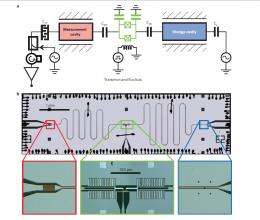July 9, 2010 feature
Quantum non-demolition measurement allows physicists to count photons without destroying them

(PhysOrg.com) -- In a way, the quantum world seems to know when it's being watched. When physicists make measurements on photons and other quantum-scale particles, the measurements always disturb the system in some way. Although an ideal disturbance should still enable physicists to make multiple measurements and get the same result twice, most real measurements cause a greater disturbance than this ideal minimum, and prohibit physicists from making repeated measurements. In a recent study, physicists have demonstrated a new way to make one of the ideal measurements - called quantum non-demolition (QND) measurements - allowing physicists to detect single particles repeatedly without destroying them.
The concept of QND measurements has been around since the beginning of quantum mechanics, and physicists have demonstrated different QND measurement techniques since the ‘70s. In the latest technique, developed by a team of physicists from Yale University, Princeton University, and the University of Waterloo, the scientists have shown how to measure the number of photons inside a microwave cavity in a way that preserves the photon state 90% of the time; in other words, the method is 90% QND. The physicists explain that, unlike previously reported QND methods, the new technique is strongly selective to chosen photon number states, which could make it useful for applications such as monitoring the state of a photon-based memory in a quantum computer.
In their experiments, the physicists wanted to find out how many photons were in a microwave cavity. To do this without disturbing the system, they coupled a superconducting qubit to a cavity. This cavity stored the photons long enough for them to be measured - or “interrogated” - by using a set of controlled-NOT (CNOT) operations to encode information about the cavity state onto the qubit state. Then the qubit and storage cavity were decoupled, and the qubit state was read out. Because the qubit state now depends on the number of photons in the cavity, measuring the qubit reveals the number of photons.
“Our method takes advantage of the ability to engineer interactions between cavities and qubits in superconducting circuits to make the qubit energies strongly depend on the number of photons in the cavity,” coauthor Blake Johnson of Yale University told PhysOrg.com. “We have made this effect large enough to build a new qubit-photon logic gate which allows us to perform conditional qubit operations based on the cavity state. This type of logic gate is not only applicable to photon readout, but also to some proposals for engineering interactions between photons by using a qubit as a mediator.”
In the new design, the photon read out time is faster than the photon decay time. This timing difference allows the physicists to measure any qubit state several times during the lifetime of photons in the storage cavity. A single interrogation process takes about 550 nanoseconds, which includes the 50-nanosecond to initialize the qubit state. As expected with a high-quality QND method, the results of repeated interrogations are essentially indistinguishable from the first. In contrast, as Johnson explained, a typical quantum measurement would destroy one photon every time, so that repeated interrogations would give different results.
“A typical photon detector, like a CCD or photo-multiplier tube, absorbs photons,” Johnson said. “These detectors don’t work for microwaves because the energy of a microwave photon is too small to generate charges. However, with a setup similar to the one used in our paper, one could measure the photon state by transferring the photon energy into the qubit. This method would destroy exactly one photon every time. In contrast, our detector does not transfer any energy. Instead, we attempt to add energy to the qubit from an external source in such a way that the success or failure of these attempts reveals information about the cavity state. You might worry that this added energy might leak into the cavity and changed the photon number, but we have checked that this does not, in fact, happen.”
Achieving QND measurements of photons, while challenging, could be very useful for the development of quantum information technologies, which require complete control of quantum measurements. As the physicists note in their study, recent progress in manipulating microwave photons in superconducting circuits has increased the demand for a QND detector that operates in the gigahertz frequency range (like the one demonstrated here). In addition, the physicists predict that further research could make it possible to observe quantum jumps of light in a circuit, among other things.
“QND detection in general is interesting because it is the only way that quantum mechanics allows to extract information from a system without modifying its state, and then allowing feedback and manipulation of the same,” Johnson said. “The applications are interesting because if one could implement feedback of a quantum system, one could imagine using these systems for quantum simulation and quantum computation, harnessing quantum mechanics toward the goal of practical application.”
More information: B.R. Johnson, et al. “Quantum non-demolition detection of single microwave photons in a circuit.” Nature Physics. Advance Online Publication. DOI:10.1038/NPHYS1710
Copyright 2010 PhysOrg.com.
All rights reserved. This material may not be published, broadcast, rewritten or redistributed in whole or part without the express written permission of PhysOrg.com.















